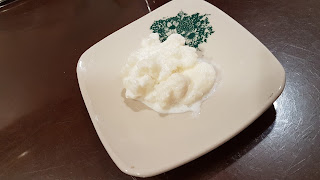Please read through this guide thoroughly first at least once before you begin.
Note: pictures are for illustration purposes only.
Things to Watch Out For:
1) Never use metallic items such as spoons, strainers, bowls or jars to handle kefir, except when you are consuming it.
2) Always keep your kefir capped well. You don't want anything foreign going into it. Notable insects that just love kefir are flies, especially the fruit flies a.k.a "mun jeet".
3) Fermented kefir milk becomes more and more sour the longer you leave it. If you do not want your fermented kefir milk to be too sour for your own liking, consume the kefir within one day after filtering the grains out.
4) Fermented kefir milk is absolutely fine for lactose intolerant people to consume.
5) As you do this over the course of a few months, you will notice a marked increase in kefir grains being filtered out. You can then give the extra grains away to friends if you like. Spread the love! :D
Getting Started:
1) Get a minimum 3 watertight glass jars of the same make (Recommended. Reason? See step 4. Yes, you will have a spare jar without a cap. Keep it as a replacement just in case.) which can contain volumes of approximately 400-500ml. Shown below are the 2 types of jars that I use. (More details on where to obtain them later but you are free to use any other type of glass jar that you are comfortable with.)
.
or
.
.
.JPG)
2) Wash clean and dry all of the glass jars, put in all of the kefir grains that you just acquired into one of the jars and pour in the fresh milk. (Any brand, as long as it is fresh. FRESH. Easily obtained off the fridge of any super or hypermarket.) Fill up to brim and cap it back.
3) Since it is your first fermentation with the grains, you can just leave the jar outside at room temperature, maybe on your kitchen or dining table for about 15-18 hours. Just make sure it is firmly capped back to keep the pests out.
Note: For your first fermentation, you can actually let it ferment slightly less than 15 hours, or longer than 18 hours as a one-off event. The main idea is to actually adapt and integrate the whole process required to produce kefir to your life schedule. It wouldn't be practical to follow to book to and wake up at 3am in the morning to do your kefir, would it? After doing this once, you can have the option of fermenting and then straining it in intervals of a minimum of 12 hours. So plan your schedule well. Kefir grains also need love, ya know ^_^
4) In the meantime while you wait, you can make a filter out of one of the jar's cap so that you can strain out the grains easier (Just screw the cap on and pour!). The one shown below is done myself by drilling holes into the cap. Of course, you can also use your own strainer if you like.
.JPG)
5) After 15-18 hours..... OK! Enough waiting and lets get down to business. Screw on your improvised cap-strainer or just use your normal strainer, and separate the grains from the fermented kefir milk, which should be collected in a bowl.
.JPG)
.JPG)
6) If you used your improvised cap-strainer, you will have the added ease of just removing the cap-strainer, refill the jar with fresh milk with the grains already inside the jar. Otherwise, just put the grains back into the original jar and refill with fresh milk. Then cap the jar back.
7) As for the fermented kefir milk collected in the bowl, you can either consume it immediately; or pour it into another glass jar, cap it and put it aside. If you do the latter, you will have a fermented kefir milk of a much different consistency to consume. As can be seen below, the fermented kefir milk will gradually separate into two clearly defined layers over the course of 12 hours. The top layer will be smoothly cheesy while the bottom layer will be a whey like liquid. Should you want to consume it in this state, just beat up and stir the top layer with the bottom layer and consume.
.JPG) 8) Repeat the process over and over again! :D
8) Repeat the process over and over again! :D--------------------------------------------------------------------------------------------------------------------------------------------------------------------
Other pictures:
.JPG)
.JPG)
.JPG)
.JPG)
.JPG)





